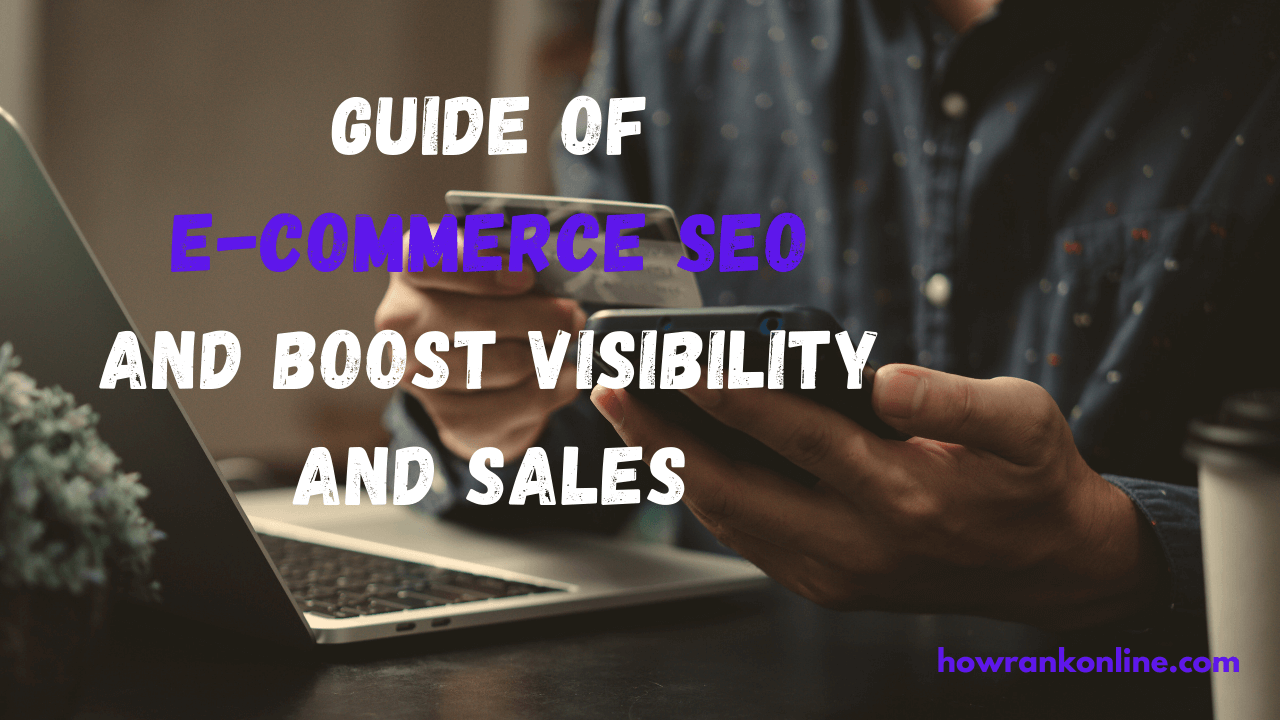In the fast-paced world of digital evolution, it’s not just beneficial but absolutely necessary to build a strong online presence to thrive in e-commerce. With an ever-increasing number of consumers turning to the internet to fulfill their shopping needs, businesses must harness the power of effective Search Engine Optimization (SEO) strategies to stand out amidst fierce competition. This comprehensive guide aims to delve deep into the intricacies of e-commerce SEO Services, offering invaluable insights and practical tips to empower businesses in driving traffic, enhancing visibility, and ultimately, increasing conversions.
Table of Contents
1. The Significance of E-Commerce SEO
In an era where online shopping has become the norm rather than the exception, the significance of e-commerce SEO cannot be overstated. Gone are the days when merely having an e-commerce website sufficed; today, businesses must actively optimize their online platforms to ensure maximum visibility and accessibility to potential customers. E-commerce SEO serves as the cornerstone of this optimization effort, enabling businesses to improve their search engine rankings, attract organic traffic, and ultimately, boost sales and revenue.
2. Benefits of E-Commerce SEO
Enhanced Visibility: With millions of websites vying for attention on search engine results pages (SERPs), achieving high visibility is crucial for e-commerce success. A well-executed SEO strategy can propel a business’s website to the top of SERPs, ensuring that it is prominently featured when users search for relevant products or services.
Improved Credibility: High search rankings not only increase visibility but also signal credibility and trustworthiness to potential customers. Studies have shown that users are more likely to click on organic search results than paid advertisements, viewing them as more authentic and reliable sources of information.
Increased Traffic and Conversions: By optimizing their websites for relevant keywords and user intent, businesses can attract qualified leads and drive more traffic to their e-commerce platforms. Furthermore, targeted SEO efforts can lead to higher conversion rates, as users who find what they’re looking for are more likely to make a purchase or engage with the website.
Cost-Effectiveness: Unlike paid advertising, which demands continuous investment to uphold visibility, SEO presents a budget-friendly approach to drawing organic traffic and cultivating leads. Though implementing SEO demands time and effort, its enduring advantages surpass the initial input, rendering it a sustainable and effective marketing tactic.
3. Strategies for Effective E-Commerce SEO
3.1 Conduct Comprehensive Keyword Research
Keyword research lies at the heart of any successful SEO campaign. By identifying the keywords and phrases that are most relevant to their products or services, businesses can tailor their website content to match user search queries effectively. Tools such as Google Keyword Planner, SEMrush, and Ahrefs can provide valuable insights into search volume, competition, and keyword trends, allowing businesses to identify high-potential keywords to target.
In addition to traditional keyword research, businesses should also consider long-tail keywords, which are more specific and typically have lower competition. Long-tail keywords allow businesses to target niche audiences and capture highly qualified leads, increasing the likelihood of conversions.
3.2 Optimize Product Pages for Maximum Impact
Product pages serve as the gateway to an e-commerce website, making them crucial for SEO optimization. Each product page should be meticulously optimized to ensure maximum visibility and engagement. Key areas to focus on include:
Title Tags and Meta Descriptions: These elements should contain relevant keywords and accurately describe the content of the page, enticing users to click through to the website.
Product Descriptions: High-quality, informative product descriptions not only help users understand the features and benefits of a product but also provide opportunities to incorporate relevant keywords naturally.
Images and Alt Text: Optimizing product images with descriptive filenames and alt text not only improves accessibility for visually impaired users but also provides another opportunity to include keywords.
User Reviews and Ratings: User-generated content such as reviews and ratings can enhance the credibility of a product page and provide valuable insights for potential customers.
3.3 Prioritize User Experience (UX)
In the realm of e-commerce, user experience is paramount. A well-designed, user-friendly website not only enhances the overall customer experience but also improves search engine rankings. Factors such as page load speed, mobile responsiveness, intuitive navigation, and clear calls-to-action all contribute to a positive user experience.
One often-overlooked aspect of UX optimization is site architecture. A clear and logical site structure not only makes it easier for users to navigate the website but also helps search engines understand the hierarchy and relevance of different pages. By organizing content into categories and subcategories and implementing internal linking strategies, businesses can improve both user experience and SEO performance.
3.4 Harness the Power of Content Marketing
Content is king in the world of SEO, and e-commerce websites are no exception. By creating high-quality, relevant content that addresses the needs and interests of their target audience, businesses can attract organic traffic and establish themselves as authorities in their niche. Content marketing strategies for e-commerce include:
Blog Posts: Publishing informative blog posts on topics related to the products or services offered can attract users at various stages of the buying journey and drive organic traffic to the website.
Product Guides and Tutorials: Providing in-depth product guides and tutorials not only helps users make informed purchasing decisions but also demonstrates the expertise and authority of the business.
User-Generated Content: Encouraging customers to share their experiences through reviews, testimonials, and social media posts not only provides valuable social proof but also generates user-generated content that can improve search engine rankings.
3.5 Build a Strong Backlink Profile
Backlinks are a crucial ranking factor in Google’s search algorithm, serving as endorsements of a website’s authority and relevance. Earning high-quality backlinks from reputable websites in the industry can significantly improve search rankings and drive more organic traffic. Strategies for building backlinks include:
Guest Blogging: Writing guest posts for relevant websites in the industry can help businesses reach new audiences and earn valuable backlinks.
Influencer Outreach: Partnering with influencers and industry experts to promote products or services can generate buzz and attract backlinks from their followers.
Content Syndication: Sharing content on reputable platforms and websites can increase its visibility and attract inbound links from interested readers.
Industry Forums and Communities: Participating in online forums and communities related to the industry can help businesses establish credibility and earn backlinks from engaged users.
3.6 Leverage Social Media to Amplify Your Reach
While social media signals may not directly impact search rankings, they play a crucial role in amplifying content and expanding online reach. By sharing valuable, engaging content on platforms like Facebook, Instagram, Twitter, and LinkedIn, businesses can attract more visitors to their e-commerce websites and increase brand visibility. Additionally, social media activity can indirectly contribute to SEO by generating social signals and fostering community engagement.
4. Monitoring and Measuring Success
Tracking key performance indicators (KPIs) is essential for evaluating the effectiveness of e-commerce SEO efforts and identifying areas for improvement. Key metrics to monitor include:
- Organic Traffic: Measure the volume and quality of organic traffic to the website over time, tracking changes in search rankings and click-through rates.
- Keyword Rankings: Monitor the rankings of target keywords to gauge the impact of SEO efforts and identify opportunities for optimization.
- Conversion Rate: Track the percentage of visitors who complete desired actions, such as making a purchase or signing up for a newsletter, to assess the effectiveness of the website in driving conversions.
- Bounce Rate: Evaluate the percentage of visitors who leave the website without engaging further, identifying potential issues with user experience or content relevance.
- Backlink Profile: Assess the quantity and quality of backlinks pointing to the website to measure authority and credibility in the eyes of search engines.
By regularly analyzing these metrics and adjusting SEO strategies accordingly, businesses can optimize their e-commerce websites for sustained success in the competitive online marketplace.
Deep Digger: 10 Best SEO Plugins For WordPress
5. Conclusion
In conclusion, e-commerce SEO is a powerful tool for driving traffic, increasing visibility, and maximizing conversions. By implementing the strategies outlined in this guide and staying abreast of industry trends and best practices, businesses can position themselves for long-term success in the digital economy. Whether you’re a small boutique or a multinational retailer, investing in SEO is essential for thriving in today’s hypercompetitive e-commerce landscape. So don’t wait—start optimizing your e-commerce website for search engines today and unleash its full potential. With dedication, strategic planning, and continuous optimization, businesses can harness the power of e-commerce SEO to achieve their goals and stay ahead of the competition.







